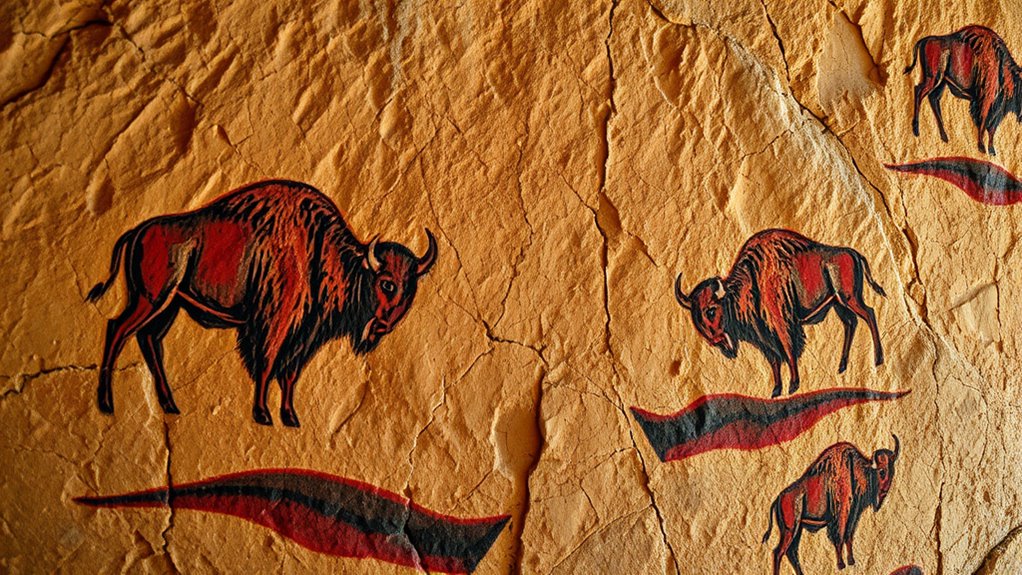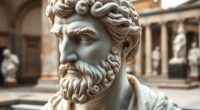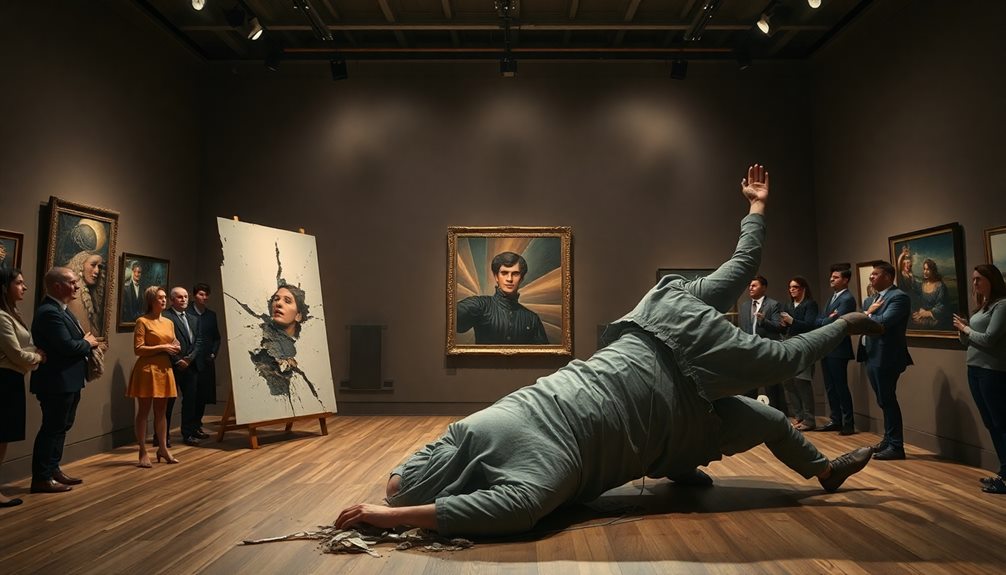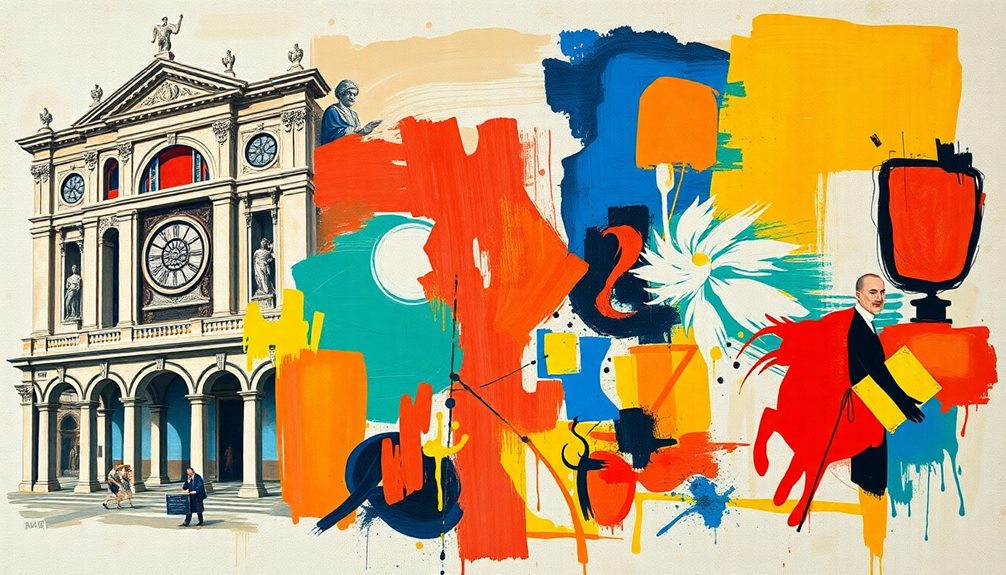Early art began with your ancient ancestors using natural pigments and simple tools to create cave paintings and carvings. These works served as tools for communication, storytelling, and spiritual beliefs, often portraying animals, symbols, and significant events. Techniques evolved from applying mineral dyes with primitive brushes to more sophisticated methods over time. If you explore further, you’ll discover how these early methods laid the foundation for the rich artistic traditions that shape civilizations today.
Key Takeaways
- Early art originated in caves and rocks, serving communication, spiritual beliefs, and record-keeping for prehistoric humans.
- Natural pigments like ochre and charcoal were used with primitive tools to create durable images.
- Symbols and motifs conveyed layered meanings related to animals, hunting magic, and spiritual concepts.
- Art was integral to rituals, social norms, and sharing knowledge across generations in ancient societies.
- Modern art techniques build upon these early innovations, reflecting the evolution from primitive methods to sophisticated creations.

Have you ever wondered how early humans expressed themselves before written language? Long before the invention of writing systems, your ancestors used art as a powerful way to communicate, record experiences, and connect with their surroundings. These early creations, often found in caves and on rocks, are the foundation of what we now call early art. They relied heavily on prehistoric symbolism, using images and motifs that carried meaning beyond their simple appearance. These symbols could represent animals, spiritual beliefs, or important events, allowing early humans to convey complex ideas across generations. To create these images, they employed primitive techniques—using natural pigments like ochre, charcoal, and mineral-based dyes—applied with their fingers, bones, or rudimentary brushes made from plant fibers. This approach was both practical and innovative, transforming raw natural materials into vibrant, lasting images. The durability of these artworks was often enhanced by the natural environment, which helped preserve them for millennia. Additionally, early humans often used prehistoric symbolism to encode stories and beliefs, making their art a form of early storytelling.
In these ancient artworks, you see how early humans sought to capture their world and their beliefs through symbolic representations. For instance, animal figures dominate many cave paintings, not just as depictions of their environment but as spiritual symbols or hunting magic to ensure success. The act of painting was more than mere decoration; it was a ritual, a way to communicate with spirits or ancestors, or to mark significant events. The use of primitive techniques allowed them to create these images efficiently, often on uneven surfaces, using simple tools and materials readily available in their environment. These techniques, though primitive by today’s standards, demonstrate a remarkable understanding of materials and a deep desire to leave a mark. Furthermore, the choice of surfaces, such as cave walls with uneven textures, showcases their adaptability and ingenuity in working with available resources.
As you explore early art, you realize that it wasn’t merely about aesthetics. It was about meaning, survival, and community. The symbols and motifs carved or painted into caves served as a shared language, a way to pass down knowledge about hunting, social norms, or spiritual beliefs. The durability of these images testifies to their importance—they were not just temporary sketches but enduring messages meant to withstand the test of time. The primitive techniques used allowed for quick application but also ensured the longevity of the images, often preserved for thousands of years in the dark, stable environment of caves. These early artworks reveal that even in their most basic forms, humans have always sought to understand and represent their world, laying the groundwork for the rich artistic traditions that would follow across civilizations. Additionally, understanding the Paint Sprayer Zone techniques used today offers insight into the evolution of these primitive methods, highlighting how technological advances have built upon early innovations to create more refined and enduring art forms.
This progression underscores the importance of understanding historical artistic techniques to appreciate how early humans laid the foundation for modern artistic expression.
Frequently Asked Questions
How Did Early Humans Create Their Paintings Without Modern Tools?
You might wonder how early humans created their paintings without modern tools. They used prehistoric techniques like natural pigments from minerals, charcoal, and plants, mixing them with water or animal fat. They applied these with their hands, brushes made from plant fibers, or even blowing pigment through hollow bones. Artifact analysis reveals these methods, showing their ingenuity in using available resources to create lasting images on cave walls.
What Materials Were Commonly Used in Ancient Cave Art?
You might be surprised, but ancient cave artists mainly used natural pigment sources like charcoal, ochre, and clay for their paintings. They applied various painting techniques, including blowing pigment through hollow bones and using brushes made from animal hair or plant fibers. These materials and methods allowed them to create vivid images on cave walls, revealing their stories and beliefs long before modern tools existed.
How Does Early Art Reflect the Beliefs of Ancient Civilizations?
You see that early art often reflects the spiritual beliefs and symbolic representation of ancient people. When you look at cave paintings or carvings, you realize they weren’t just decorative—they expressed their connection to gods, nature, or the afterlife. These images reveal what they valued, feared, or hoped for, showing how their beliefs shaped their creative expressions and helped them communicate complex spiritual ideas across generations.
Were Women Equally Involved in Early Artistic Practices?
You might wonder if women played a significant role in early artistic practices. Gender roles varied, but evidence suggests women participated in artistic collaboration, contributing to early art. Some artifacts depict women in creative roles or as subjects, indicating their involvement wasn’t limited. While men’s roles often dominated, women’s participation shows that early art wasn’t solely male-driven, reflecting a more complex picture of gender roles in ancient creative endeavors.
How Did Early Art Influence Later Artistic Developments?
Did you know that early art laid the foundation for centuries of creative growth? It profoundly influenced later artistic developments by showcasing symbolic expression and sparking stylistic evolution. Your understanding of ancient symbols helps you appreciate how early artists communicated ideas, beliefs, and cultures. This legacy shapes modern art, reminding you that creativity’s roots run deep, inspiring you to explore new styles while honoring the rich history behind them.
Conclusion
As you step back from these ancient artworks, you hold a mirror to your own soul—each stroke a heartbeat, each image a window into human spirit. The cave paintings and symbols are like guiding stars, lighting your path through time’s dark forest. They remind you that art is the eternal flame, a symbol of connection, expression, and hope that burns within us all, spanning centuries to keep our shared story alive.









